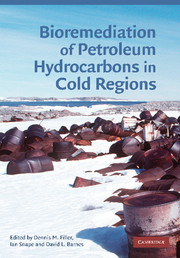Book contents
- Frontmatter
- Contents
- List of contributors
- Preface
- Glossary
- 1 Contamination, regulation, and remediation: an introduction to bioremediation of petroleum hydrocarbons in cold regions
- 2 Freezing and frozen soils
- 3 Movement of petroleum through freezing and frozen soils
- 4 Hydrocarbon-degrading bacteria in contaminated cold soils
- 5 Temperature effects on biodegradation of petroleum contaminants in cold soils
- 6 Analytical methods for petroleum in cold region soils
- 7 Treatability studies: microcosms, mesocosms, and field trials
- 8 Nutrient requirements for bioremediation
- 9 Landfarming
- 10 Thermally enhanced bioremediation and integrated systems
- 11 Emerging technologies
- References
- Index
1 - Contamination, regulation, and remediation: an introduction to bioremediation of petroleum hydrocarbons in cold regions
Published online by Cambridge University Press: 22 August 2009
- Frontmatter
- Contents
- List of contributors
- Preface
- Glossary
- 1 Contamination, regulation, and remediation: an introduction to bioremediation of petroleum hydrocarbons in cold regions
- 2 Freezing and frozen soils
- 3 Movement of petroleum through freezing and frozen soils
- 4 Hydrocarbon-degrading bacteria in contaminated cold soils
- 5 Temperature effects on biodegradation of petroleum contaminants in cold soils
- 6 Analytical methods for petroleum in cold region soils
- 7 Treatability studies: microcosms, mesocosms, and field trials
- 8 Nutrient requirements for bioremediation
- 9 Landfarming
- 10 Thermally enhanced bioremediation and integrated systems
- 11 Emerging technologies
- References
- Index
Summary
Introduction
Oil and fuel spills are among the most extensive and environmentally damaging pollution problems in cold regions and are recognized as potential threats to human and ecosystem health. It is generally thought that spills are more damaging in cold regions, and that ecosystem recovery is slower than in warmer climates (AMAP 1998; Det Norske Veritas 2003). Slow natural attenuation rates mean that petroleum concentrations remain high for many years, and site managers are therefore often forced to select among a range of more active remediation options, each of which involves a trade-off between cost and treatment time (Figure 11). The acceptable treatment timeline is usually dictated by financial circumstance, perceived risks, regulatory pressure, or transfer of land ownership.
In situations where remediation and site closure are not urgent, natural attenuation is often considered an option. However, for many cold region sites, contaminants rapidly migrate off-site (Gore et al. 1999; Snape et al. 2006a). In seasonally frozen ground, especially in wetlands, a pulse of contamination is often released with each summer thaw (AMAP 1998; Snape et al. 2002). In these circumstances natural attenuation is likely not a satisfactory option. Simply excavating contaminants and removing them for off-site treatment may not be viable either, because the costs are often prohibitive and the environmental consequences of bulk extraction can equal or exceed the damage caused by the initial spill (Filler et al. 2006; Riser-Roberts 1998).
- Type
- Chapter
- Information
- Publisher: Cambridge University PressPrint publication year: 2008
- 3
- Cited by

